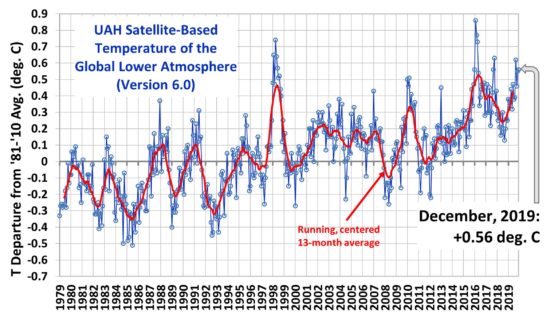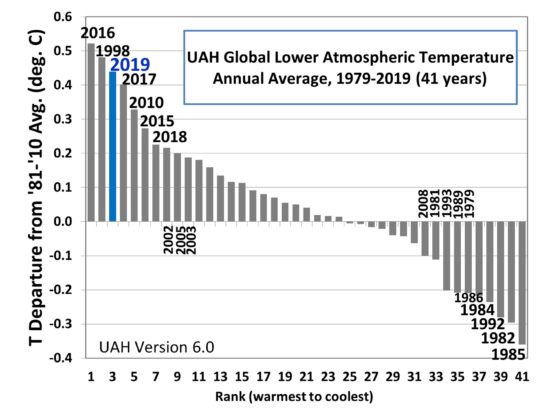2019 was the third warmest year (+0.44 deg. C) in the 41 year satellite record, after 2016 (+0.52 deg. C) and 1998 (+0.48 deg. C).
The Version 6.0 global average lower tropospheric temperature (LT) anomaly for December, 2019 was +0.56 deg. C, statistically unchanged from the November value of +0.55 deg. C.

The yearly rankings over the 41-year satellite-based temperature record shows 2019 as the third warmest, behind 2016 and 1998.

The linear warming trend since January, 1979 remains at +0.13 C/decade (+0.11 C/decade over the global-averaged oceans, and +0.18 C/decade over global-averaged land).
Various regional LT departures from the 30-year (1981-2010) average for the last 24 months are:
YEAR MO GLOBE NHEM. SHEM. TROPIC USA48 ARCTIC AUST 2018 01 +0.29 +0.51 +0.07 -0.10 +0.70 +1.39 +0.52 2018 02 +0.25 +0.28 +0.21 +0.05 +0.99 +1.22 +0.35 2018 03 +0.28 +0.43 +0.12 +0.08 -0.19 -0.32 +0.76 2018 04 +0.21 +0.32 +0.10 -0.14 +0.06 +1.02 +0.84 2018 05 +0.16 +0.38 -0.05 +0.02 +1.90 +0.14 -0.24 2018 06 +0.20 +0.33 +0.06 +0.12 +1.10 +0.77 -0.41 2018 07 +0.30 +0.38 +0.23 +0.28 +0.41 +0.24 +1.49 2018 08 +0.18 +0.21 +0.16 +0.11 +0.02 +0.11 +0.37 2018 09 +0.13 +0.14 +0.13 +0.22 +0.89 +0.23 +0.28 2018 10 +0.20 +0.27 +0.12 +0.30 +0.20 +1.08 +0.43 2018 11 +0.26 +0.24 +0.28 +0.46 -1.16 +0.68 +0.55 2018 12 +0.25 +0.35 +0.15 +0.30 +0.24 +0.69 +1.20 2019 01 +0.38 +0.35 +0.41 +0.36 +0.53 -0.15 +1.15 2019 02 +0.37 +0.47 +0.28 +0.43 -0.02 +1.04 +0.05 2019 03 +0.35 +0.44 +0.25 +0.41 -0.55 +0.96 +0.59 2019 04 +0.44 +0.38 +0.51 +0.54 +0.50 +0.92 +0.91 2019 05 +0.32 +0.29 +0.35 +0.40 -0.61 +0.98 +0.39 2019 06 +0.47 +0.42 +0.52 +0.64 -0.64 +0.91 +0.35 2019 07 +0.38 +0.33 +0.44 +0.45 +0.11 +0.33 +0.87 2019 08 +0.39 +0.38 +0.39 +0.42 +0.17 +0.44 +0.24 2019 09 +0.62 +0.64 +0.59 +0.60 +1.14 +0.75 +0.57 2019 10 +0.46 +0.64 +0.28 +0.31 -0.03 +0.99 +0.50 2019 11 +0.55 +0.56 +0.54 +0.55 +0.21 +0.56 +0.38 2019 12 +0.56 +0.61 +0.50 +0.58 +0.92 +0.66 +0.94
The UAH LT global anomaly image for December, 2019 should be available in the next few days here.
The global and regional monthly anomalies for the various atmospheric layers we monitor should be available in the next few days at the following locations:
Lower Troposphere: http://vortex.nsstc.uah.edu/data/msu/v6.0/tlt/uahncdc_lt_6.0.txt
Mid-Troposphere: http://vortex.nsstc.uah.edu/data/msu/v6.0/tmt/uahncdc_mt_6.0.txt
Tropopause: http://vortex.nsstc.uah.edu/data/msu/v6.0/ttp/uahncdc_tp_6.0.txt
Lower Stratosphere: http://vortex.nsstc.uah.edu/data/msu/v6.0/tls/uahncdc_ls_6.0.txt

 Home/Blog
Home/Blog



